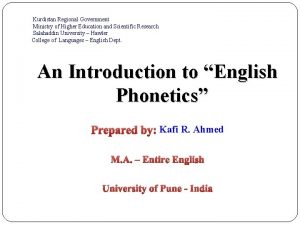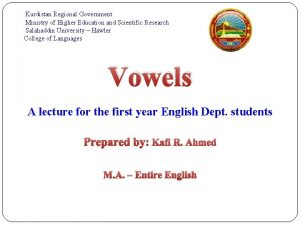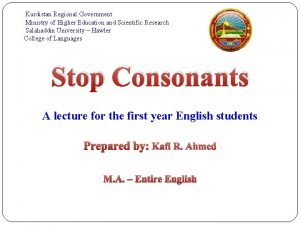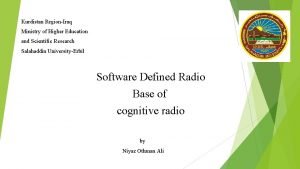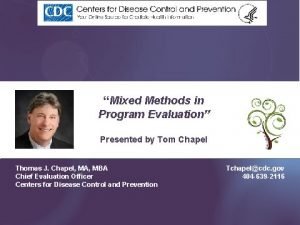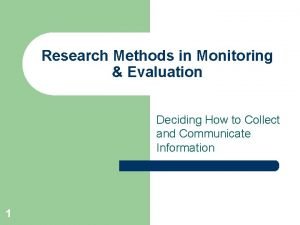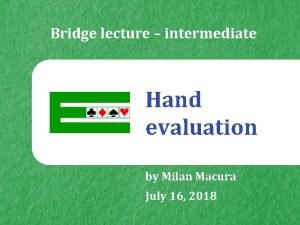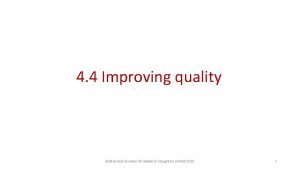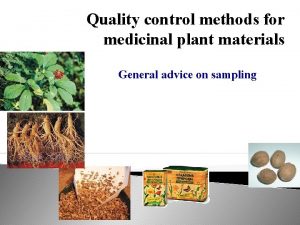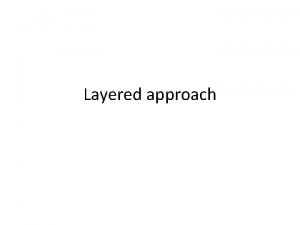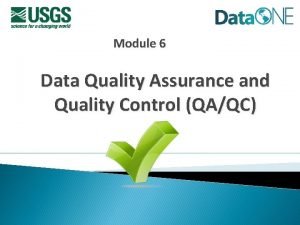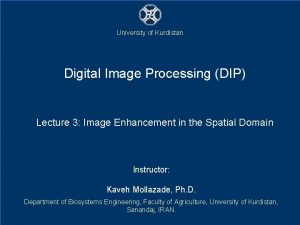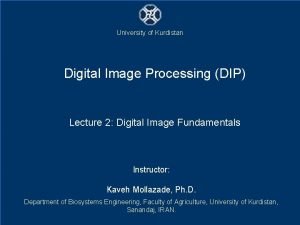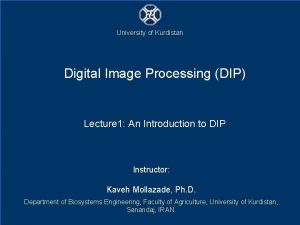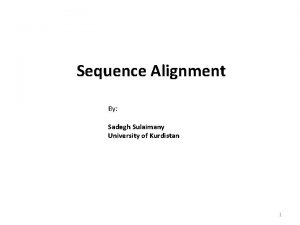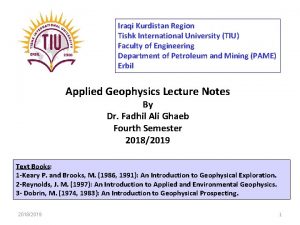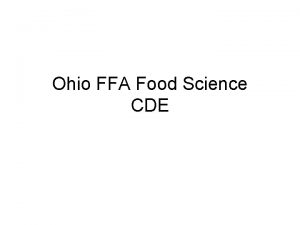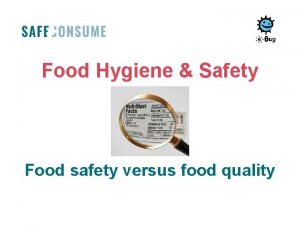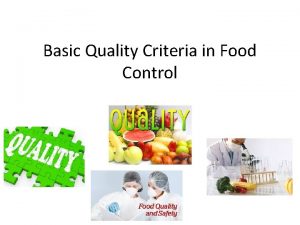University of Kurdistan Food Quality Evaluation Methods FQEM



























- Slides: 27


University of Kurdistan Food Quality Evaluation Methods (FQEM) Lecture 5: Ultrasound Instructor: Kaveh Mollazade, Ph. D. Department of Biosystems Engineering, Faculty of Agriculture, University of Kurdistan, Sanandaj, IRAN.

Contents • This lecture will cover: – An introduction to ultrasound – Principles of ultrasound – Devices and apparatus – Ultrasonic testing techniques Food Quality Evaluation Methods– Department of Biosystems Engineering – University of Kurdistan http: //agri. uok. ac. ir/kmollazade 1

Introduction q Ultrasonic measurement is a promising, nondestructive sensing method of characterizing materials by transmitting mechanical waves at frequencies above 20 k. Hz through a material, and investigating the characteristics of the transmitted or reflected ultrasound waves. Food Quality Evaluation Methods– Department of Biosystems Engineering – University of Kurdistan http: //agri. uok. ac. ir/kmollazade 2

Introduction q Offering advantages including non-destructiveness, rapidity, relatively low cost, and potential for automatic application, ultrasonic techniques provide a very useful and versatile method for investigating the physical properties of materials. q Ultrasonic waves may be reflected and transmitted when they pass from one medium to another. The amount of energy reflected and transmitted through materials depends on their relative acoustic impedances, as defined by the density and velocity of the penetrating wave within and between material interfaces. Food Quality Evaluation Methods– Department of Biosystems Engineering – University of Kurdistan http: //agri. uok. ac. ir/kmollazade 3

Introduction q In addition to ultrasound energy attenuation, the time of flight and velocity could also serve as good indicators of material properties or variation of material characteristics, since ultrasound velocity is dependent on the density and elastic properties of the medium. q Hence, ultrasound properties are closely related to the physical properties, such as structure, texture, and physical state, of the components of the media. Food Quality Evaluation Methods– Department of Biosystems Engineering – University of Kurdistan http: //agri. uok. ac. ir/kmollazade 4

Introduction q Applications of ultrasound technology to biological engineering: Ø Cleaning foodstuffs and containers Ø Extraction of proteins and fats Ø Maturation of food Ø Food process monitoring Ø Non-destructive quality evaluation of agricultural, marine, and livestock food products Food Quality Evaluation Methods– Department of Biosystems Engineering – University of Kurdistan http: //agri. uok. ac. ir/kmollazade 5

Introduction q The application of ultrasound in the field of food process can be divided into two branches: Ø One is the application of high energy level ultrasound for surface cleaning, dehydration, promotion of drying and filtration, activity control of microorganisms and enzymes, cell division, removal of gas from liquid materials, promotion of heat transfer, acceleration of extraction, and so on. Ø The other branch is the application of low energy level ultrasound for controlling the food process and evaluating the quality of food. Food Quality Evaluation Methods– Department of Biosystems Engineering – University of Kurdistan http: //agri. uok. ac. ir/kmollazade 6

Principles: Propagation of ultrasound q If stress is applied to an elastic material, it produces a progression of waves, which are referred to as elastic waves. q Two kinds of elastic waves can arise in an isotropic material: longitudinal and shear waves. q The direction of particle displacement in a longitudinal wave is parallel to the direction of wave propagation, while the direction of particles in a shear (transverse) wave is perpendicular to the direction of propagation. q There are two types of shear waves perpendicular to one another, horizontal shear waves and vertical shear waves, which propagate horizontally and vertically with the shear planes. Food Quality Evaluation Methods– Department of Biosystems Engineering – University of Kurdistan http: //agri. uok. ac. ir/kmollazade 7

Principles: Propagation of ultrasound q In a fluid, the stress state, which is a pure pressure, only has a longitudinal component; however, in a solid, the stress state includes a shear component as well. Food Quality Evaluation Methods– Department of Biosystems Engineering – University of Kurdistan http: //agri. uok. ac. ir/kmollazade 8

Principles: Propagation of ultrasound q The wave propagation in an unbounded isotropic elastic solid medium is expressed as follows: ρ : Density u : Displacement of particle in the medium λ : Lame constants G : Shear modulus Food Quality Evaluation Methods– Department of Biosystems Engineering – University of Kurdistan http: //agri. uok. ac. ir/kmollazade 9

Principles: Propagation of ultrasound q If there is only longitudinal deformation without transverse deformation (∇×u=0): Ø where cp is the velocity of a longitudinal wave and is defined as follows: Ø where E is the Young’s modulus of the medium and μ is the Poisson’s ratio. Food Quality Evaluation Methods– Department of Biosystems Engineering – University of Kurdistan http: //agri. uok. ac. ir/kmollazade 10

Principles: Propagation of ultrasound q If only transverse deformation exists (∇×u=0) in the medium: Ø where cs is the velocity of shear wave and is defined as follows: q Using the above equations, the mechanical properties of materials, such as Young’s modulus (E), shear modulus (G), and Poisson’s ratio (μ), can be calculated with the measured parameters of the density (ρ), and the velocity of the longitudinal and shear waves (cp, cs) of the materials. Food Quality Evaluation Methods– Department of Biosystems Engineering – University of Kurdistan http: //agri. uok. ac. ir/kmollazade 11

Principles: Acoustic impedance q When an incident ultrasound wave propagates on an interface between two media of different properties, reflection, refraction, and scattering occur. These phenomena could be good indicators of the media properties. q Ultrasound reflection and refraction can be well explained using acoustic impedance. Z : Acoustic impedance P : Sound pressure v : Particle velocity Food Quality Evaluation Methods– Department of Biosystems Engineering – University of Kurdistan http: //agri. uok. ac. ir/kmollazade 12

Principles: Acoustic impedance q On the other hand, acoustic impedance is equal to the product of the density (ρ0) of the medium and the velocity of sound (c) in the medium. The unit is kg/m 2 s. q Hence, acoustic impedance includes both the characteristics of the wave and the medium (physical properties) simultaneously. Food Quality Evaluation Methods– Department of Biosystems Engineering – University of Kurdistan http: //agri. uok. ac. ir/kmollazade 13

Principles: Reflection and transmission Z 1 and Z 2: Acoustic impedances of mediums 1 and 2 T : Coefficient of wave transmission R : Coefficient of wave reflection Food Quality Evaluation Methods– Department of Biosystems Engineering – University of Kurdistan http: //agri. uok. ac. ir/kmollazade 14

Devices and apparatus: Ultrasonic transducers q Ultrasonic transducers are the devices that generate and receive ultrasound and convert electric energy into ultrasound energy, and vice versa. q Although numerous methods can be used to generate ultrasound waves, piezoelectric transducers are the most common types. Food Quality Evaluation Methods– Department of Biosystems Engineering – University of Kurdistan http: //agri. uok. ac. ir/kmollazade 15

Devices and apparatus: Ultrasonic transducers q The piezoelectric effect describes the relationship between the mechanical stress and the electrical voltage in a piezoelectric material, and it is reversible: an applied mechanical stress generates a voltage and an applied voltage changes the shape of the piezoelectric material. q The piezoelectric effect occurs when an electric charge develops on the faces of a piezoelectric element that is mechanically deformed. Conversely, an electric signal or voltage applied across the faces will cause deformation. q Thus, deformation of a piezoelectric material at high frequencies generates ultrasound vibrations that propagate as waves in the material through a suitable couplant. Food Quality Evaluation Methods– Department of Biosystems Engineering – University of Kurdistan http: //agri. uok. ac. ir/kmollazade 16

Devices and apparatus: Ultrasonic transducers Food Quality Evaluation Methods– Department of Biosystems Engineering – University of Kurdistan http: //agri. uok. ac. ir/kmollazade 17

Ultrasound testing techniques: Pulse-Echo method q A pulse echo describes a technique where a pulsed ultrasound beam is transmitted through a couplant into the material to be tested, travels to another surface of the material, and is then reflected back to a transducer that may or may not be a transmitting transducer. q The echo wave originating from a flaw in the testing material is indicated according to the transit time from the transmitter to the flaw and to the receiving transducer. Food Quality Evaluation Methods– Department of Biosystems Engineering – University of Kurdistan http: //agri. uok. ac. ir/kmollazade 18

Ultrasound testing techniques: Through-transmission method q Through transmission is used in several cases, particularly for highly attenuative materials such as fruit, where a pulse-echo trip results in a significant loss in signal strength. q In this method, A probe on one side of a component transmits (T) an ultrasonic pulse to a receptor (R) probe on the other side. Food Quality Evaluation Methods– Department of Biosystems Engineering – University of Kurdistan http: //agri. uok. ac. ir/kmollazade 19

Ultrasound testing techniques: Doppler method q Another important application of ultrasound is measurement of the velocity of moving fluids in food process monitoring, such as particle velocity in a pipe or channel. q The Doppler principle is by far the most popular means of acoustically measuring the velocity of a fluid or particle. q Waves reflected from moving objects are shifted in frequency by an amount proportional to the velocity of the scattering objects. The change in frequency embodies the Doppler effect, which states that the observed frequency of a wave depends on the motional states of the wave sources and the observer. Food Quality Evaluation Methods– Department of Biosystems Engineering – University of Kurdistan http: //agri. uok. ac. ir/kmollazade 20

Ultrasound testing techniques : Doppler method Food Quality Evaluation Methods– Department of Biosystems Engineering – University of Kurdistan http: //agri. uok. ac. ir/kmollazade 21

Ultrasound testing techniques : Ultrasound data displays (C-scan) q The C-scan presentation provides a plan-type view of the location and size of test specimen features. The plane of the image is parallel to the scan pattern of the transducer. C-scan presentations are produced with an automated data acquisition system, such as a computer controlled immersion scanning system. q C-scans can be made by using either pulse-echo or through-transmission inspection techniques. Food Quality Evaluation Methods– Department of Biosystems Engineering – University of Kurdistan http: //agri. uok. ac. ir/kmollazade 22

Ultrasound testing techniques: Non-contact ultrasonic measurement q Conventional ultrasound techniques depend on contact measurement using a coupling medium between the transducer and the test material to overcome the acoustic impedance mismatch between air and the material. q Use of a coupling medium, such as oils or gels, might change or destroy sample materials by absorption and interaction of the couplants. Further, the coupling medium could be a source of contamination if the test specimens are food materials. q Hence, extensive research has been performed to develop an air-coupled ultrasonic transducer to overcome the limitations of the conventional contact ultrasonic measurement technology. Food Quality Evaluation Methods– Department of Biosystems Engineering – University of Kurdistan http: //agri. uok. ac. ir/kmollazade 23

Ultrasound testing techniques: Non-contact ultrasonic measurement Food Quality Evaluation Methods– Department of Biosystems Engineering – University of Kurdistan http: //agri. uok. ac. ir/kmollazade 24

Kurdistan Nature Food Quality Evaluation Methods– Department of Biosystems Engineering – University of Kurdistan Zrebar Lake, Marivan http: //agri. uok. ac. ir/kmollazade
 Food quality evaluation
Food quality evaluation Fqem
Fqem Fqem
Fqem Fqem
Fqem Ministry of higher education krg
Ministry of higher education krg Kurdistan
Kurdistan Kurdistan
Kurdistan Kurdistan higher education
Kurdistan higher education Kurdistan investment board
Kurdistan investment board Kurdistan
Kurdistan Ministry of higher education erbil
Ministry of higher education erbil Kondistan
Kondistan Unit 2 food food food
Unit 2 food food food Food chain food chain food chain
Food chain food chain food chain A-wax pattern recognition
A-wax pattern recognition Mixed methods program evaluation
Mixed methods program evaluation Job evaluation methods
Job evaluation methods Job evaluation definition
Job evaluation definition Job evaluation methods
Job evaluation methods Computer architecture performance evaluation methods
Computer architecture performance evaluation methods Concept evaluation example
Concept evaluation example Mandryk
Mandryk Research methods in monitoring and evaluation
Research methods in monitoring and evaluation Bridge hand evaluation methods
Bridge hand evaluation methods Difficulties of improving quality business
Difficulties of improving quality business Quality control methods for medicinal plant materials
Quality control methods for medicinal plant materials Quality focus in software engineering
Quality focus in software engineering What is quality control
What is quality control





